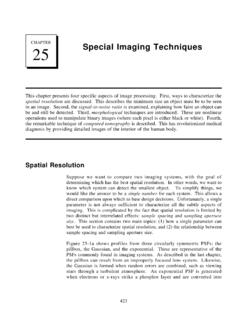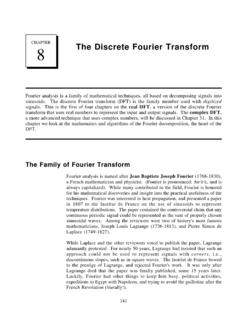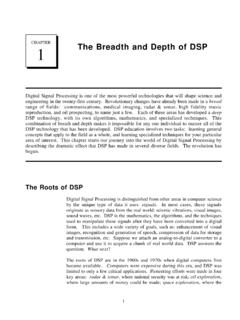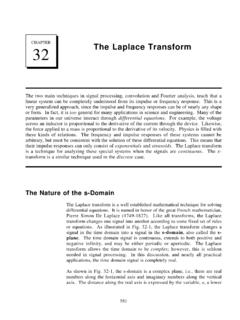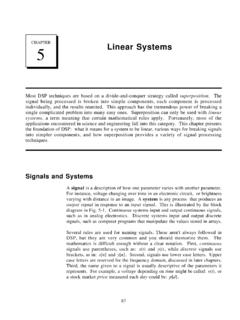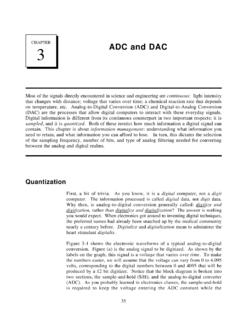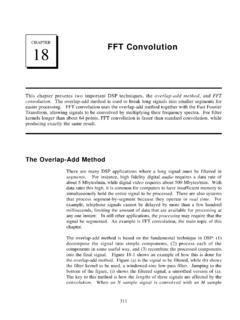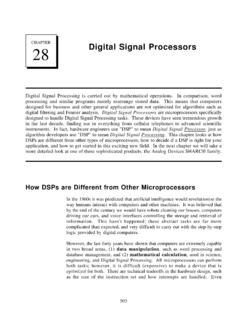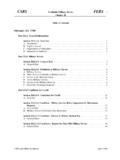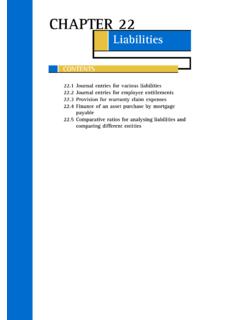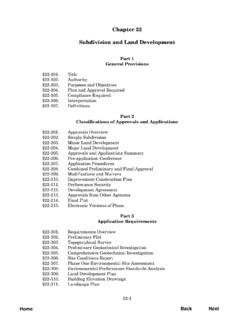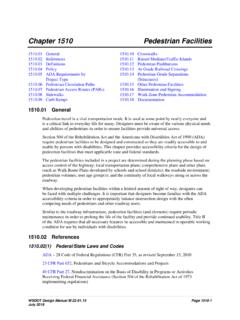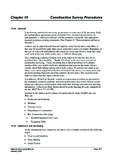Transcription of Human Hearing - Digital signal processing
1 351 CHAPTER22 Audio ProcessingAudio processing covers many diverse fields, all involved in presenting sound to Human areas are prominent: (1) high fidelity music reproduction, such as in audio compact discs,(2) voice telecommunications, another name for telephone networks, and (3) synthetic speech,where computers generate and recognize Human voice patterns. While these applications havedifferent goals and problems, they are linked by a common umpire: the Human ear. Digital SignalProcessing has produced revolutionary changes in these and other areas of audio HearingThe Human ear is an exceedingly complex organ. To make matters even moredifficult, the information from two ears is combined in a perplexing neuralnetwork, the Human brain. Keep in mind that the following is only a briefoverview; there are many subtle effects and poorly understood phenomenarelated to Human Hearing .
2 Figure 22-1 illustrates the major structures and processes that comprise thehuman ear. The outer ear is composed of two parts, the visible flap of skinand cartilage attached to the side of the head, and the ear canal, a tubeabout cm in diameter extending about 3 cm into the head. Thesestructures direct environmental sounds to the sensitive middle and inner earorgans located safely inside of the skull bones. Stretched across the end ofthe ear canal is a thin sheet of tissue called the tympanic membrane or eardrum. Sound waves striking the tympanic membrane cause it to middle ear is a set of small bones that transfer this vibration to thecochlea (inner ear) where it is converted to neural impulses. The cochleais a liquid filled tube roughly 2 mm in diameter and 3 cm in shown straight in Fig.
3 22-1, the cochlea is curled up and lookslike a small snail shell. In fact, cochlea is derived from the Greek word Scientist and Engineer's Guide to Digital signal Processing352 When a sound wave tries to pass from air into liquid, only a small fraction ofthe sound is transmitted through the interface, while the remainder of theenergy is reflected. This is because air has a low mechanical impedance (lowacoustic pressure and high particle velocity resulting from low density and highcompressibility), while liquid has a high mechanical impedance. In lesstechnical terms, it requires more effort to wave your hand in water than it doesto wave it in air. This difference in mechanical impedance results in most ofthe sound being reflected at an air/liquid interface.
4 The middle ear is an impedance matching network that increases the fractionof sound energy entering the liquid of the inner ear. For example, fish do nothave an ear drum or middle ear, because they have no need to hear in air. Most of the impedance conversion results from the difference in area betweenthe ear drum (receiving sound from the air) and the oval window (transmittingsound into the liquid, see Fig. 22-1). The ear drum has an area of about 60(mm)2, while the oval window has an area of roughly 4 (mm)2. Since pressureis equal to force divided by area, this difference in area increases the soundwave pressure by about 15 times. Contained within the cochlea is the basilar membrane, the supporting structurefor about 12,000 sensory cells forming the cochlear nerve.
5 The basilarmembrane is stiffest near the oval window, and becomes more flexible towardthe opposite end, allowing it to act as a frequency spectrum analyzer. Whenexposed to a high frequency signal , the basilar membrane resonates where it isstiff, resulting in the excitation of nerve cells close to the oval , low frequency sounds excite nerve cells at the far end of the basilarmembrane. This makes specific fibers in the cochlear nerve respond to specificfrequencies. This organization is called the place principle, and is preservedthroughout the auditory pathway into the brain. Another information encoding scheme is also used in Human Hearing , called thevolley principle. Nerve cells transmit information by generating briefelectrical pulses called action potentials.
6 A nerve cell on the basilar membranecan encode audio information by producing an action potential in response toeach cycle of the vibration. For example, a 200 hertz sound wave can berepresented by a neuron producing 200 action potentials per second. However,this only works at frequencies below about 500 hertz, the maximum rate thatneurons can produce action potentials. The Human ear overcomes this problemby allowing several nerve cells to take turns performing this single task. Forexample, a 3000 hertz tone might be represented by ten nerve cells alternatelyfiring at 300 times per second. This extends the range of the volley principleto about 4 kHz, above which the place principle is exclusively 22-1 shows the relationship between sound intensity and perceivedloudness.
7 It is common to express sound intensity on a logarithmic scale,called decibel SPL (Sound Power Level). On this scale, 0 dB SPL is a soundwave power of 10-16 watts/cm2, about the weakest sound detectable by thehuman ear. Normal speech is at about 60 dB SPL, while painful damage to theear occurs at about 140 dB 22- Audio Processing353soundwavesin airearoutercanaleartympanic membrane(ear drum)oval windowsound wavesin liquidmiddleear bonescochleabasilarmembranehighfrequency detectionmediumfrequencydetectionlowfreq uencydetectionFIGURE 22-1 Functional diagram of the Human ear. The outer ear collects sound waves from the environment and channelsthem to the tympanic membrane (ear drum), a thin sheet of tissue that vibrates in synchronization with the airwaveform.
8 The middle ear bones (hammer, anvil and stirrup) transmit these vibrations to the oval window, aflexible membrane in the fluid filled cochlea. Contained within the cochlea is the basilar membrane, the supportingstructure for about 12,000 nerve cells that form the cochlear nerve. Due to the varying stiffness of the basilarmembrane, each nerve cell only responses to a narrow range of audio frequencies, making the ear a frequencyspectrum difference between the loudest and faintest sounds that humans can hearis about 120 dB, a range of one-million in amplitude. Listeners can detect achange in loudness when the signal is altered by about 1 dB (a 12% change inamplitude). In other words, there are only about 120 levels of loudness thatcan be perceived from the faintest whisper to the loudest thunder.
9 Thesensitivity of the ear is amazing; when listening to very weak sounds, the eardrum vibrates less than the diameter of a single molecule! The perception of loudness relates roughly to the sound power to an exponentof 1/3. For example, if you increase the sound power by a factor of ten,listeners will report that the loudness has increased by a factor of about two(). This is a major problem for eliminating undesirable environmental101 , for instance, the beefed-up stereo in the next door apartment. Supposeyou diligently cover 99% of your wall with a perfect soundproof material,missing only 1% of the surface area due to doors, corners, vents, etc. Eventhough the sound power has been reduced to only 1% of its former value, theperceived loudness has only dropped to about , or 20%.
10 Range of Human Hearing is generally considered to be 20 Hz to 20 kHz,but it is far more sensitive to sounds between 1 kHz and 4 kHz. For example,listeners can detect sounds as low as 0 dB SPL at 3 kHz, but require 40 dBSPL at 100 hertz (an amplitude increase of 100). Listeners can tell that twotones are different if their frequencies differ by more than about at 3kHz. This increases to 3% at 100 hertz. For comparison, adjacent keys on apiano differ by about 6% in Scientist and Engineer's Guide to Digital signal Processing354 Watts/cm2 Decibels SPLE xample sound10-2140 dB Pain10-3130 dB10-4120 dB Discomfort10-5110 dB Jack hammers and rock concerts10-6100 dB10-7 90 dB OSHA limit for industrial noise10-8 80 dB10-9 70 dB10-10 60 dB Normal conversation10-11 50 dB10-12 40 dB Weakest audible at 100 hertz10-13 30 dB10-14 20 dB Weakest audible at 10kHz10-15 10 dB10-16 0 dB Weakest audible at 3 kHz10-17-10 dB10-18-20 dBTABLE 22-1 Units of sound intensity.
